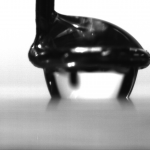In our new report on adhesion of liquids to solids, entitled “Droplet Characteristics at the Maximum Adhesion on Curved Surfaces” and published in Langmuir, we analyze the effect of solid surface curvature on liquid droplet adhesion. The following is the abstract:
For applications involving droplet detachment from solid surfaces, it is vital to study the droplet characteristics (e.g., contact angle and base width) when the droplet is experiencing the maximum force that detaches the droplet (maximum adhesion state). Historically, such investigations were mainly conducted on flat 2-dimenional surfaces and the characteristics on curved surfaces with third dimension remain unknown. Thus, the generalized description of such characteristics has not been established yet. Here, by vertically pulling liquid droplets using a microbalance, we study the droplet characteristics at the maximum adhesion on curved homogeneous surfaces. Variables in this study include liquid surface tension, initial droplet base area, and the asymmetry in solid surface curvature. Results show that the contact angle is identical everywhere along the droplet perimeter on curved surfaces irrespective of the asymmetry in surface curvature because the surface curvature is a macroscopic parameter that cannot affect the contact angle, which is determined by surface microscopic properties. In addition, we found the droplet base is non-axisymmetric (not circular) at the maximum adhesion, opposing previous understanding that was formulated for flat surfaces. As a result, we propose a more generalized and quantitative description of the droplet characteristics at the maximum adhesion, derived from the component of the surface tension force acting along the droplet perimeter.
Liquid Adhesion to Curved Surface
This entry was posted in Publications. Bookmark the permalink.

